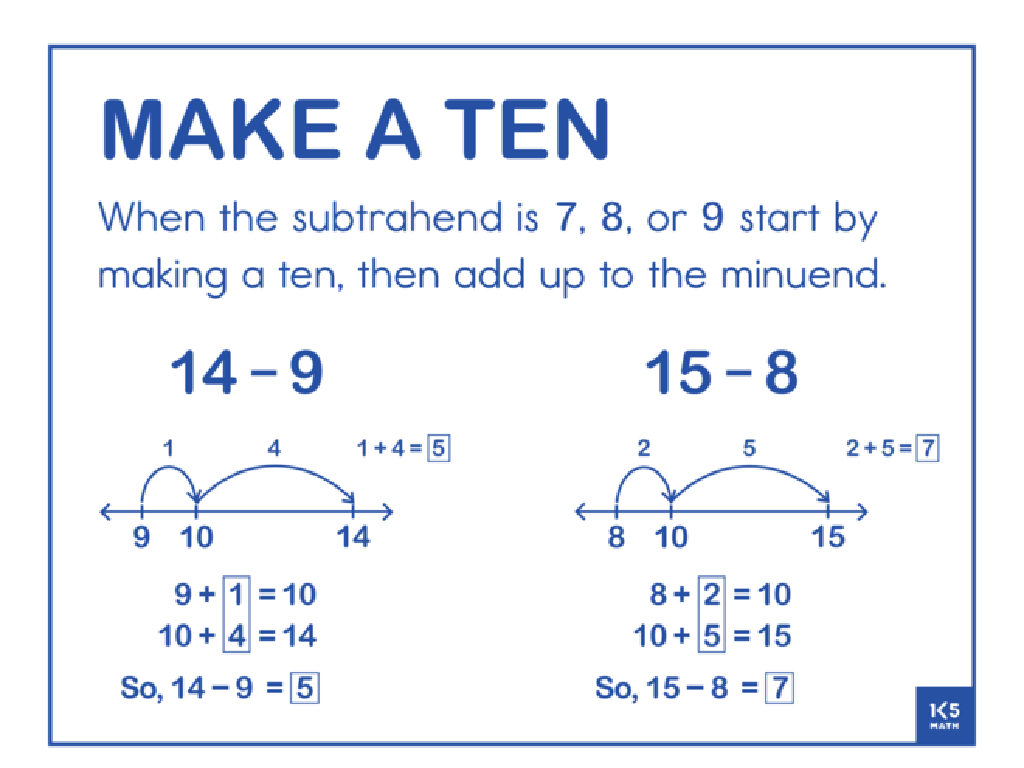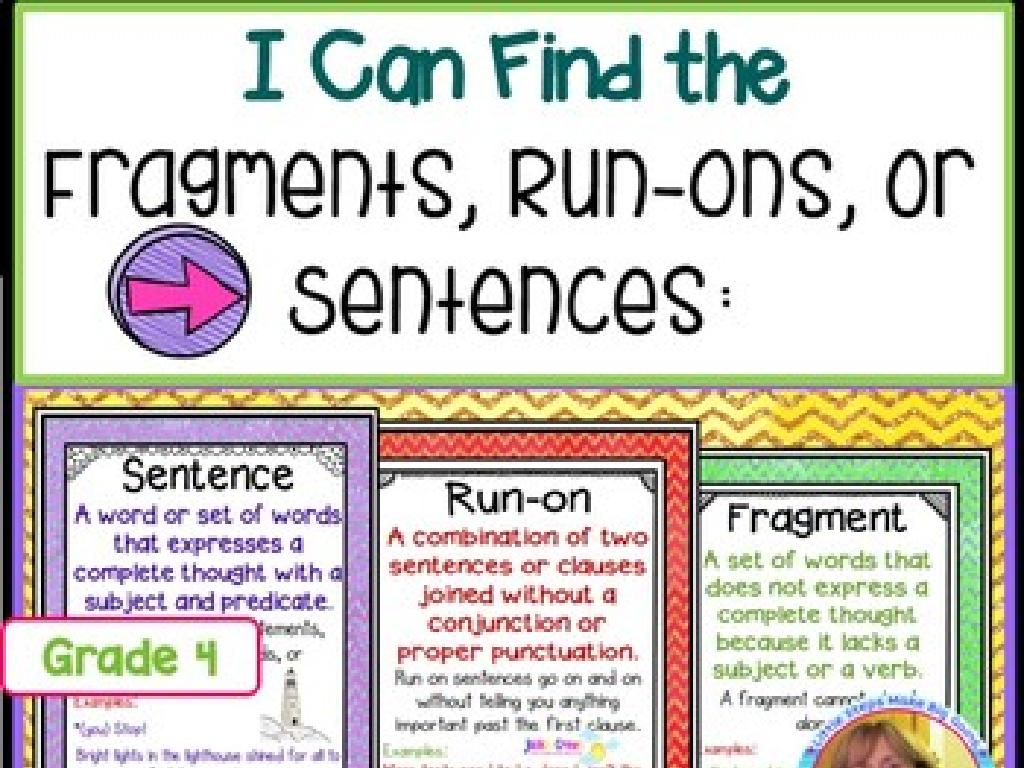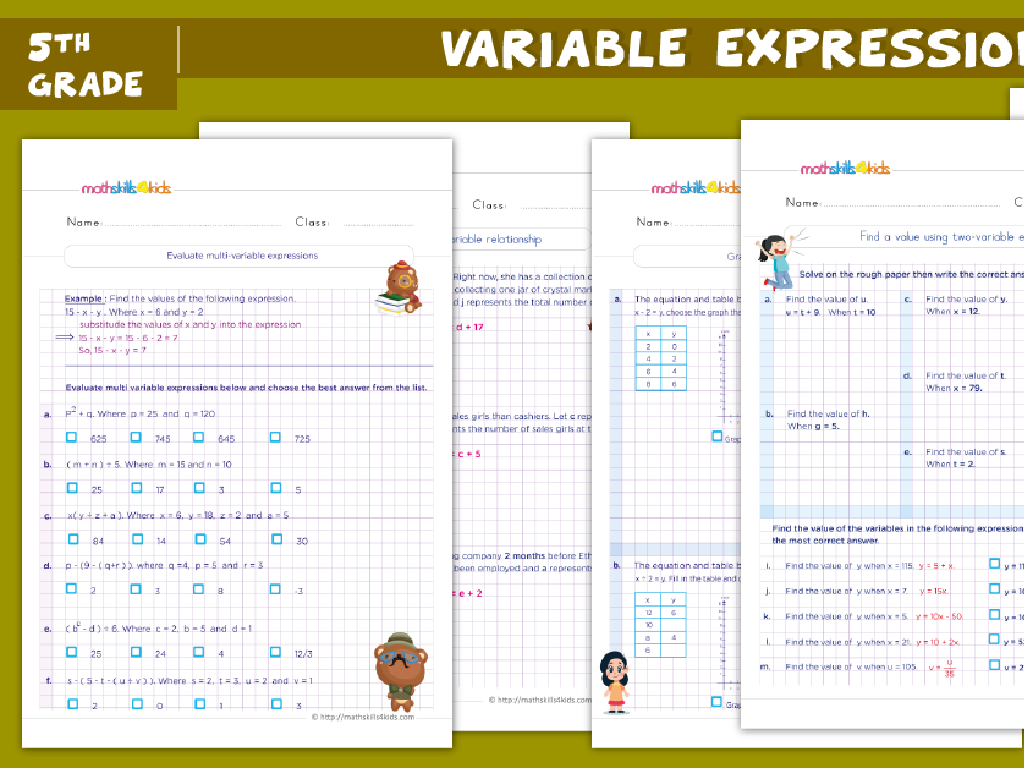Direct And Indirect Objects
Subject: Language arts
Grade: Sixth grade
Topic: Prepositions
Please LOG IN to download the presentation. Access is available to registered users only.
View More Content
Prepositions and Objects in Sentences
– Define direct objects
– The receiver of the action in a sentence, e.g., ‘She kicked the ball.’
– Define indirect objects
– The recipient of the direct object, e.g., ‘She gave him the ball.’
– How they fit in sentences
– Direct objects answer ‘what?’ and indirect objects answer ‘to whom?’ or ‘for whom?’ after the verb.
– Examples in literature
– Identify objects in sentences from books or stories.
|
This slide introduces the concept of direct and indirect objects as parts of a sentence structure in the context of prepositions. Direct objects are the nouns or pronouns receiving the action of the verb, while indirect objects are the entities that receive the direct object. It’s crucial to explain that not all sentences contain indirect objects, but they always follow the verb and precede the direct object if present. Use examples from familiar stories or books to illustrate how these objects function within a sentence. Encourage students to practice by identifying the direct and indirect objects in sentences they create or from reading passages.
Exploring Prepositions
– Define a preposition
– A word that connects nouns/pronouns to other words
– Prepositions show relationships
– They link nouns/pronouns to time, location, direction, etc.
– Common prepositions: on, in, by
– Examples: ‘on the table’, ‘in the car’, ‘by the tree’
– Usage in sentences
– ‘The cat slept under the stars.’ – ‘under’ shows where the cat slept
|
This slide introduces the concept of prepositions to the students, explaining that prepositions are words that establish relationships between nouns or pronouns and other parts of a sentence. Emphasize that prepositions can indicate time, place, direction, and other relationships. Provide common examples of prepositions and use them in simple sentences to illustrate their function. Encourage students to think of additional examples and to practice identifying prepositions in sentences they encounter in their reading or daily conversations.
Identifying Prepositions
– Finding prepositions in sentences
– Look for words that show location or time
– Prepositions’ role in meaning
– See how changing prepositions changes sentence meaning
– Examples of prepositions
– ‘On the table’, ‘before dinner’, ‘under the bridge’
– Activity: Identify prepositions
– Pick sentences from a book and find the prepositions
|
This slide is aimed at helping students understand the role of prepositions in sentences. Begin by explaining that prepositions are words that link nouns, pronouns, or phrases to other words within a sentence. They typically indicate location (‘on’, ‘under’, ‘behind’), time (‘before’, ‘after’, ‘during’), and direction (‘to’, ‘from’, ‘up’). Show students how the meaning of a sentence can change when the preposition changes. Provide clear examples to illustrate this. For the activity, encourage students to choose sentences from a book and identify the prepositions. This will help them recognize prepositions in context and understand their importance in sentence structure.
Understanding Direct Objects
– Direct objects receive action
– It’s the target of the verb’s action
– Ask ‘What?’ or ‘Whom?’ after verbs
– Helps identify the direct object in a sentence
– Example: ‘She kicked the ball.’
– ‘ball’ answers ‘What did she kick?’
|
This slide introduces the concept of direct objects in sentences, which are essential for understanding sentence structure. A direct object is the noun or pronoun that receives the action of the verb. To find the direct object, students can ask ‘What?’ or ‘Whom?’ in relation to the verb. For example, in the sentence ‘She kicked the ball,’ asking ‘What did she kick?’ helps identify ‘ball’ as the direct object. It’s important for students to practice with multiple examples to become comfortable identifying direct objects. Encourage them to bring sentences from their favorite books or write their own to share with the class.
Understanding Indirect Objects
– What is an indirect object?
– It’s the recipient of the direct object in a sentence.
– How to find an indirect object?
– Ask ‘To whom?’ or ‘For whom?’ after the direct object.
– Example: ‘She kicked the ball’
– In ‘She kicked her brother the ball’, what did she kick?
– Identifying ‘brother’ as indirect
– ‘Brother’ received the ball, so he is the indirect object.
|
This slide aims to clarify the concept of indirect objects for sixth-grade students. An indirect object is someone or something that receives the direct object. To identify it, students should locate the direct object first, then ask ‘To whom?’ or ‘For whom?’ The example provided will help illustrate the concept. ‘She kicked the ball’ is the action. ‘To whom?’ – her brother. Therefore, ‘brother’ is the indirect object. Encourage students to practice with more sentences and to share their examples in class.
Direct and Indirect Objects: Examples and Practice
– Identify direct objects in sentences
– The direct object receives the action of the verb.
– Find indirect objects in examples
– The indirect object is who or what receives the direct object.
– Discuss meaning changes
– Changing objects can alter the sentence’s meaning.
– Practice with class activities
|
This slide is aimed at helping students identify and understand the roles of direct and indirect objects in sentences. Direct objects are the nouns or pronouns that receive the action of the verb, while indirect objects are the recipients of the direct objects. To illustrate this, provide clear examples where students can pinpoint these objects. Engage the class in a discussion on how swapping these objects can change the meaning of a sentence. For practice, create interactive activities where students work in groups to identify the direct and indirect objects in various sentences. This will reinforce their learning and help them grasp the concept through application.
Your Turn: Crafting Sentences with Objects
– Create sentences with provided verbs and prepositions
– Include a direct object in each sentence
– The direct object is what receives the action of the verb
– Include an indirect object in each sentence
– The indirect object is who or what the action is done for
– Share your sentences with the class
|
This activity is designed to help students practice constructing sentences that include both direct and indirect objects, using specific verbs and prepositions. A direct object answers ‘what?’ or ‘whom?’ after the verb, and the indirect object answers ‘to whom?’, ‘for whom?’, ‘to what?’, or ‘for what?’ after the action. For example, ‘She gave (verb) the dog (indirect object) a bone (direct object).’ Encourage creativity and ensure that students understand the role of each object in the sentence. After they have created their sentences, ask volunteers to share with the class to foster a collaborative learning environment.
Class Activity: Object Relay
– Form groups for relay race
– Write sentences with objects
– Include prepositions, direct objects, or indirect objects
– Each student adds a part
– Aim for clarity and correctness
|
This interactive class activity is designed to reinforce the concepts of prepositions, direct objects, and indirect objects. Divide the class into small groups and have them form a line. Provide a starting sentence on the board. The first student in each group will add a preposition, the next a direct object, and the following an indirect object, then repeat the cycle. The goal is to create sentences that are clear and grammatically correct. This exercise will help students understand sentence structure and the function of different types of objects within a sentence. Possible variations of the activity could include using different starting sentences for each group, challenging students to create the longest coherent sentence, or having a competition to see which group can create the most sentences in a given time frame.
Review and Reflect: Prepositions and Objects
– Recap on prepositions, direct and indirect objects
– Prepositions link nouns, pronouns and phrases to other words in a sentence. Direct objects receive the action of the verb, while indirect objects are entities that are affected by the action.
– Understanding the importance of sentence components
– Knowing these helps us construct clear and effective sentences.
– Discuss challenges faced
– Reflect on parts that were difficult to understand.
– Share enjoyable aspects of learning
– Talk about the parts of the lesson that were fun or interesting.
|
This slide aims to consolidate the students’ understanding of prepositions, direct objects, and indirect objects. It’s crucial for students to grasp these concepts as they are fundamental to building well-structured sentences, which is essential for effective communication. Encourage students to reflect on their learning experience, discussing any difficulties they encountered and what they found enjoyable. This reflection helps in reinforcing their knowledge and provides valuable feedback on teaching methods. It also allows students to learn from each other’s experiences and perspectives.
Homework: Prepositions, Direct & Indirect Objects
– Write 10 sentences with prepositions
– Circle prepositions in each sentence
– Prepositions show relationships in a sentence
– Underline the direct objects
– Direct objects receive the action of the verb
– Highlight the indirect objects
– Indirect objects are who/what the action is done for
|
This homework assignment is designed to reinforce the students’ understanding of prepositions, direct objects, and indirect objects. Students should create sentences that include all three elements. They will visually distinguish each component by circling, underlining, and highlighting, which aids in recognizing their roles within a sentence. For example, in the sentence ‘I gave my friend a gift,’ ‘gave’ is the verb, ‘my friend’ is the indirect object, and ‘a gift’ is the direct object. ‘To’ is the preposition if the sentence is rephrased as ‘I gave a gift to my friend.’ Encourage students to use a variety of prepositions and to think carefully about the sentence structure. This exercise will help them to visually and conceptually separate these elements, which is crucial for their language development.






